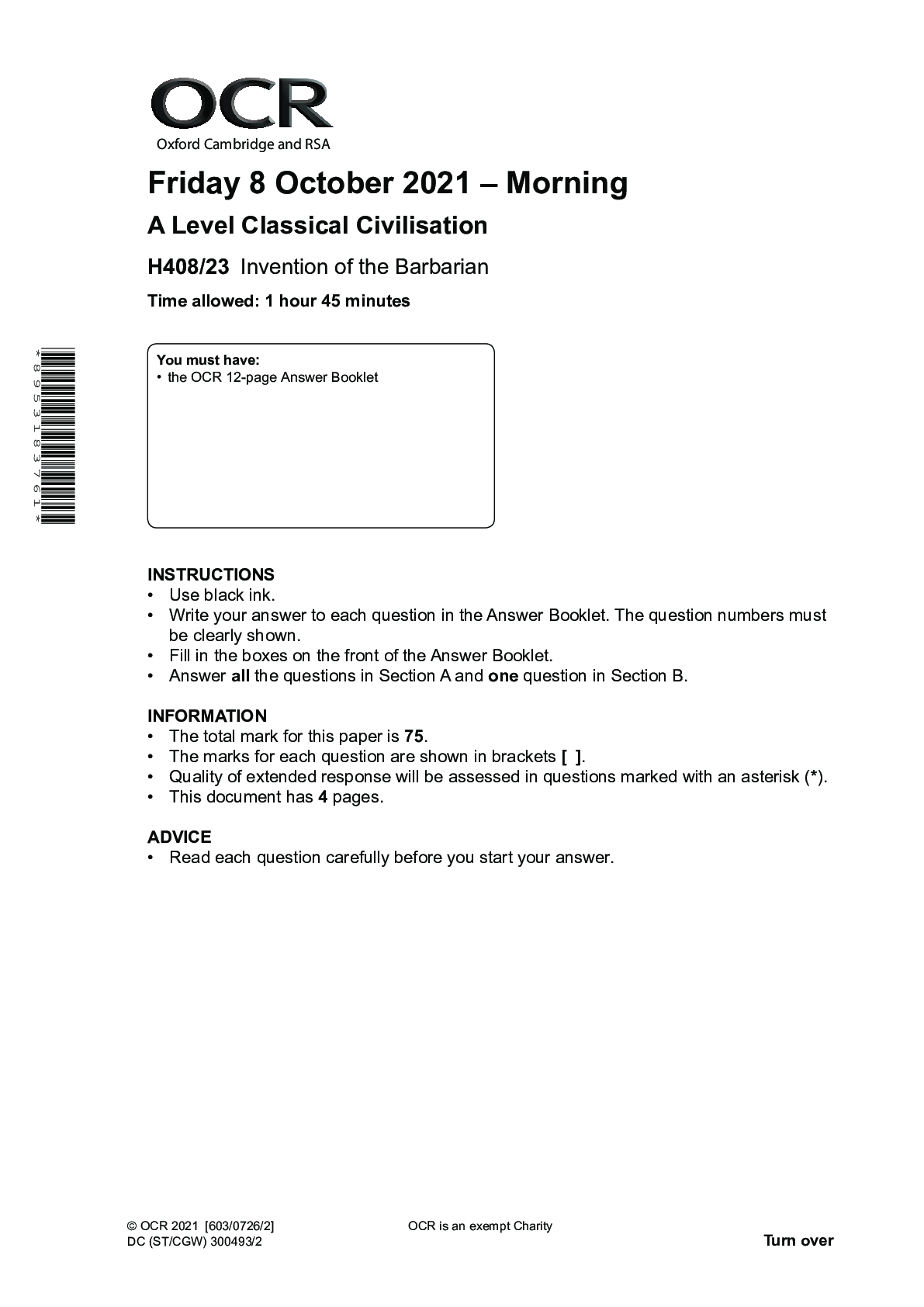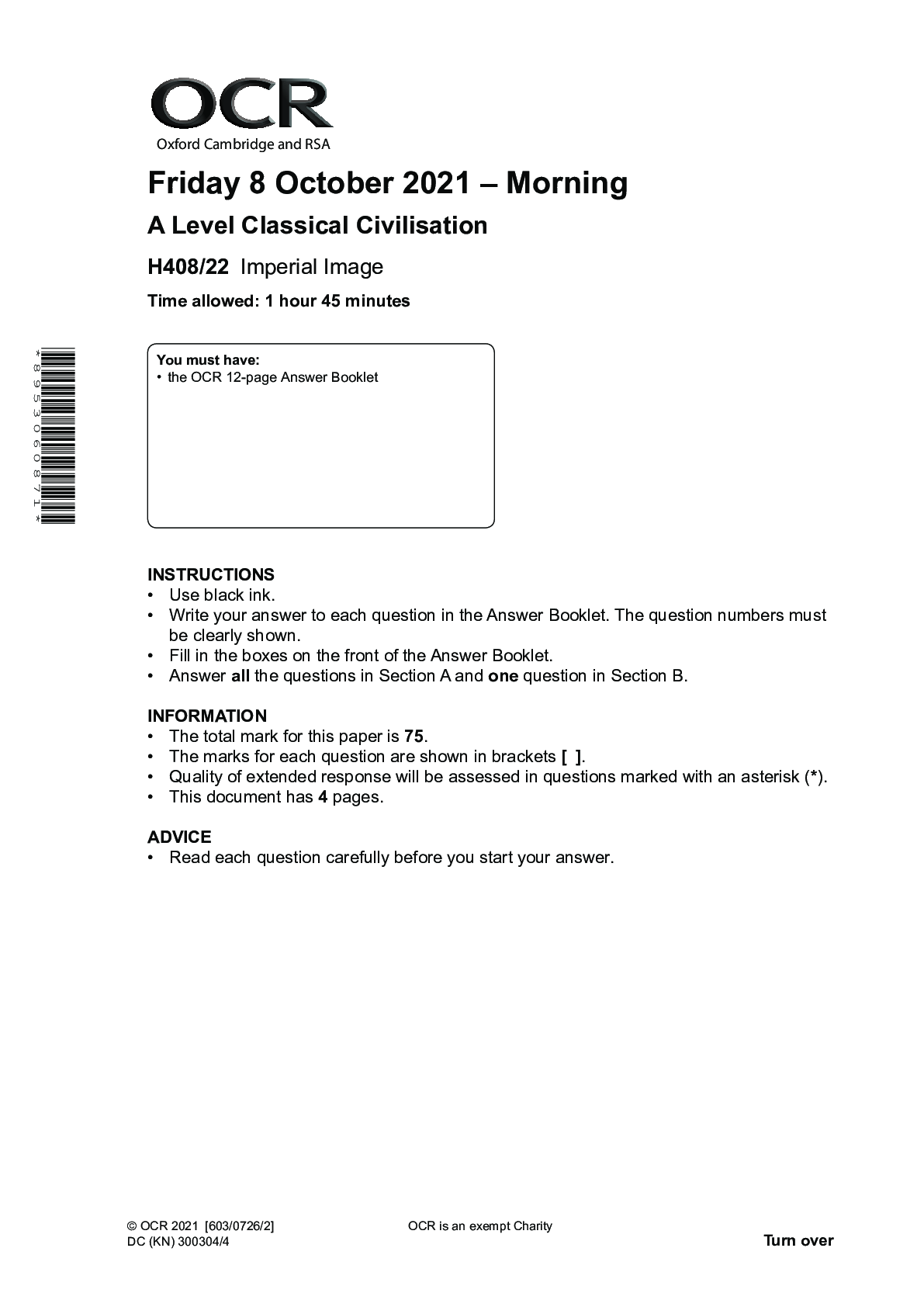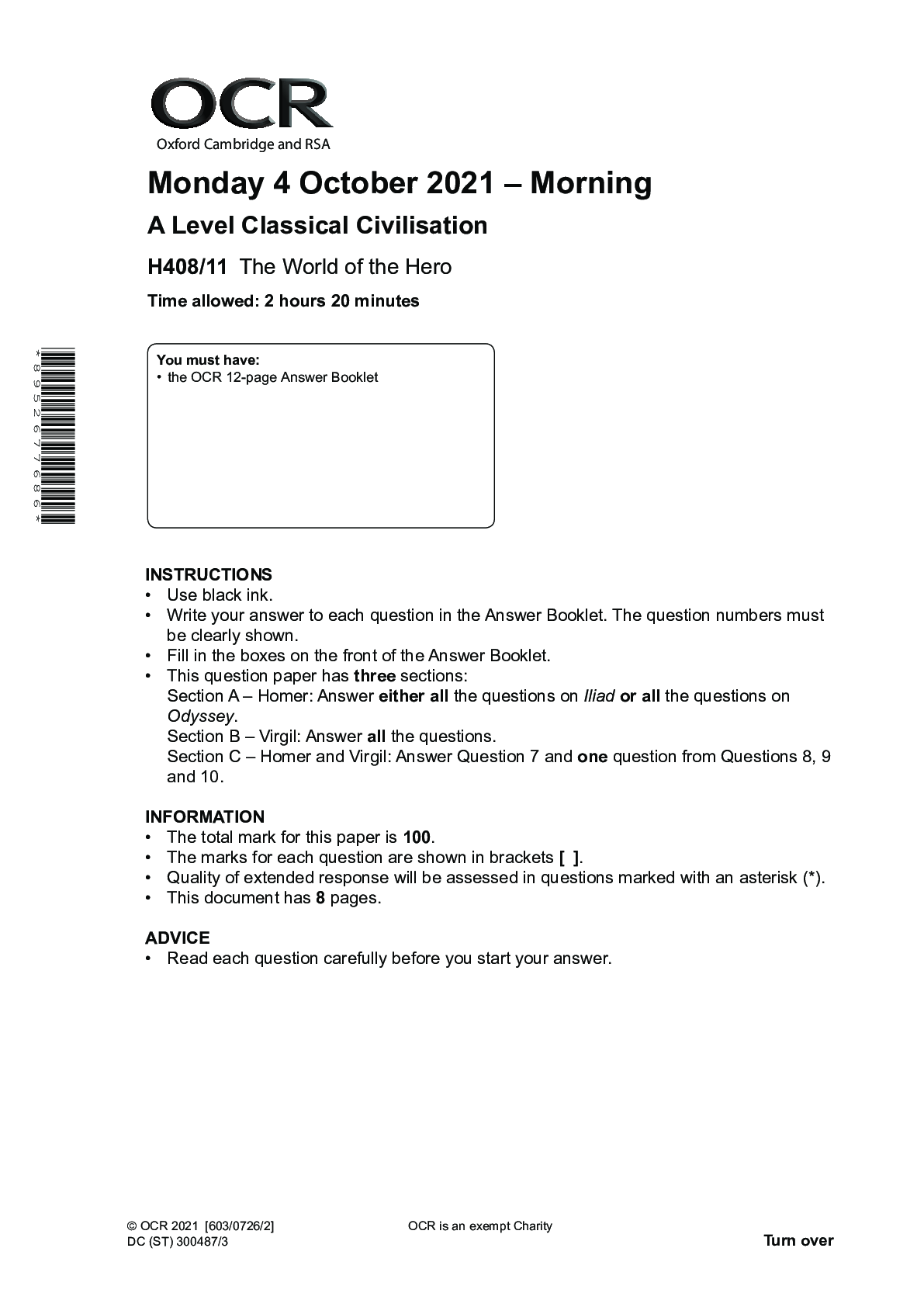Classical Civilisation > QUESTION PAPER & MARK SCHEME > OCR A Level Classical Civilisation H408/23 Invention of the barbarian Practice Paper (All)
OCR A Level Classical Civilisation H408/23 Invention of the barbarian Practice Paper
Document Content and Description Below
Answer all the questions in this section. Source A: Detail of the south frieze of the temple of Athena Nike from the Acropolis showing a battle between Greeks and Persians. 1 How can you tell that ... the figure on the left in Source A represents a Persian? Give two reasons. [2] 2 Which battle does the frieze in Source A commemorate? [1] 3 Describe how typical the portrayal of Greeks and Persians is in Source A. [10] 3 © OCR 2018 Practice paper H408/23 Turn over Source B: Aeschylus The Persians lines 69–93 CHORUS: Long since, the king led his destroying ranks Over the strait to Europe’s neighbour ground; Crossed Helle’s channel with a road that floats, A ribbon of lashed timbers and nailed planks Yoking the sea’s neck in a bridge of boats. Thus the Great King, in one impetuous bound, Launches this myriad flock, this prodigy Of armies, in two sweeps, by land and sea, Against the whole earth; his resolve made bold By all his captains’ fierce fidelity; Himself the peer of gods, whose race was sown in gold. From the darkness of his glance Glares a gory dragon’s eye. See his thousand oars advance! See ten thousand arrows fly! The royal chariot rides before; Asia’s conquering bows defy Hellene spearmen famed in war. For when armies in their pride Like a vast flood leap and roar, Then no fame in war so sure As can stem that ocean-tide; No strong bulwark so secure. Persian arms no strength can stay; Persian hearts no fear can sway. 5 10 15 20 25 4 Name the strait referred to in line 2 of Source B. [1] 5 What is the name of the ‘Great King’ mentioned in line 6 of Source B? [1] 6 Explain how Aeschylus emphasises the power of the Persian forces in Source B. [10] 7* Assess how effectively the Greeks portray themselves and the Persians. You may use Source A and Source B as a starting point for your answer. [20] [Section A Total: 45] 4 © OCR 2018 Practice paper H408/23 Oxford Cambridge and RSA Copyright Information OCR is committed to seeking permission to reproduce all third-party content that it uses in its assessment materials. OCR has attempted to identify and contact all copyright holders whose work is used in this paper. To avoid the issue of disclosure of answer-related information to candidates, all copyright acknowledgements are reproduced in the OCR Copyright Acknowledgements Booklet. This is produced for each series of examinations and is freely available to download from our public website (www.ocr.org.uk) after the live examination series. If OCR has unwittingly failed to correctly acknowledge or clear any third-party content in this assessment material, OCR will be happy to correct its mistake at the earliest possible opportunity. For queries or further information please contact The OCR Copyright Team, The Triangle Building, Shaftesbury Road, Cambridge CB2 8EA. OCR is part of the Cambridge Assessment Group; Cambridge Assessment is the brand name of University of Cambridge Local Examinations Syndicate (UCLES), which is itself a department of the University of Cambridge. SECTION B Answer one of the following questions. Use classical sources, and secondary sources, scholars and/or academic works to support your argument. You should also consider possible interpretations of sources by different audiences. Either 8* ‘The Greeks portrayed ‘barbarians’ as being opposite to them in every way.’ Assess how far this is an accurate summary of Greek artistic and literary representations of ‘barbarians’. [30] Or 9* ‘The power of the Persian empire was based entirely on military force.’ Explain how far you agree with this statement. [30] [Section B Total: 30] END OF QUESTION PAPER C10044/1.1 Practice Paper A Level Classical Civilisation H408/23 Invention of the Barbarian MARK SCHEME Duration: 1 hour 45 minutes MAXIMUM MARK 75 Final Version 1.1 This document consists of 17 pages H408/23 Mark Scheme Practice Paper 2 PREPARATION FOR MARKING ON RM ASSESSOR 1. Make sure that you have accessed and completed the relevant training packages for on-screen marking: RM Assessor Online Training; OCR Essential Guide to Marking. 2. Make sure that you have read and understood the mark scheme and the question paper for this unit. These are posted on the RM Cambridge Assessment Support Portal http://www.rm.com/support/ca. 3. Log-in to RM Assessor and mark the required number of practice responses (‘scripts’) and the required number of standardisation responses. 4. After the standardisation meeting: YOU MUST MARK 10 PRACTICE AND 10 STANDARDISATION RESPONSES BEFORE YOU CAN BE APPROVED TO MARK LIVE SCRIPTS. MARKING INSTRUCTIONS 1. Mark strictly to the mark scheme. 2. Marks awarded must relate directly to the marking criteria. 3. The schedule of dates is very important. It is essential that you meet the RM Assessor 50% and 100% deadlines. If you experience problems, you must contact your Team Leader (Supervisor) without delay. 4. If you are in any doubt about applying the mark scheme, consult your Team Leader by telephone, email or via the RM Assessor messaging system. 5. Crossed Out Responses Where a candidate has crossed out a response and provided a clear alternative then the crossed out response is not marked. Where no alternative response has been provided, examiners may give candidates the benefit of the doubt and mark the crossed out response where legible. Rubric Error Responses – Optional Questions Where candidates have a choice of question across a whole paper or a whole section and have provided more answers than required, then all responses are marked and the highest mark allowable within the rubric is given. Enter a mark for each question answered into RM assessor, which will select the highest mark from those awarded. (The underlying assumption is that the candidate has penalised themselves by attempting more questions than necessary in the time allowed.) Contradictory Responses When a candidate provides contradictory responses, then no mark should be awarded, even if one of the answers is correct. Short Answer Questions (requiring only a list by way of a response, usually worth only one mark per response) H408/23 Mark Scheme Practice Paper 3 Where candidates are required to provide a set number of short answer responses then only the set number of responses should be marked. The response space should be marked from left to right on each line and then line by line until the required number of responses have been considered. The remaining responses should not then be marked. Examiners will have to apply judgement as to whether a ‘second response’ on a line is a development of the ‘first response’, rather than a separate, discrete response. (The underlying assumption is that the candidate is attempting to hedge their bets and therefore getting undue benefit rather than engaging with the question and giving the most relevant/correct responses.) Short Answer Questions (requiring a more developed response, worth two or more marks) If the candidates are required to provide a description of, say, three items or factors and four items or factors are provided, then mark on a similar basis – that is downwards (as it is unlikely in this situation that a candidate will provide more than one response in each section of the response space.) Longer Answer Questions (requiring a developed response) Where candidates have provided two (or more) responses to a medium or high tariff question which only required a single (developed) response and not crossed out the first response, then only the first response should be marked. Examiners will need to apply professional judgement as to whether the second (or a subsequent) response is a ‘new start’ or simply a poorly expressed continuation of the first response. 6. Always check the pages (and additional objects if present) at the end of the response in case any answers have been continued there. If the candidate has continued an answer there then add a tick to confirm that the work has been seen. a. Where generic answer booklets are used, all pages must contain an annotation, or RM Assessor will not allow you to submit the script. Where no response is given by a candidate on a whole page the ‘BP’ annotation must be applied. b. Where additional objects are present, all pages must contain an annotation, or RM Assessor will not allow you to submit the script. Where no response is given by a candidate on a whole page the ‘BP’ annotation must be applied. 7. Where candidates have a choice of questions across a whole paper or a whole section and have provided more answers than required, then all responses are marked and the highest mark allowable within the rubric is given. Enter a mark for each question answered into RM assessor, which will select the highest mark from those awarded. (The underlying assumption is that the candidate has penalised themselves by attempting more questions than necessary in the time allowed.) 8. Award No Response (NR) if: • there is nothing written in the answer space. Award Zero ‘0’ if: • anything is written in the answer space and is not worthy of credit (this includes text and symbols). Team Leaders must confirm the correct use of the NR button with their markers before live marking commences and should check this when reviewing scripts. H408/23 Mark Scheme Practice Paper 4 9. The RM Assessor comments box is used by your Team Leader to explain the marking of the practice responses. Please refer to these comments when checking your practice responses. Do not use the comments box for any other reason. If you have any questions or comments for your Team Leader, use the phone, the RM Assessor messaging system, or e-mail. 10. Assistant Examiners will send a brief report on the performance of candidates to their Team Leader (Supervisor) via email by the end of the marking period. The report should contain notes on particular strengths displayed as well as common errors or weaknesses. Constructive criticism of the question paper/mark scheme is also appreciated. 11. For answers marked by levels of response: a. To determine the level – start at the highest level and work down until you reach the level that matches the answer b. To determine the mark within the level, consider the following: Descriptor Award mark On the borderline of this level and the one below At bottom of level Just enough achievement on balance for this level Above bottom and either below middle or at middle of level (depending on number of marks available) Meets the criteria but with some slight inconsistency Above middle and either below top of level or at middle of level (depending on number of marks available) Consistently meets the criteria for this level At top of level Annotations These are the annotations, (including abbreviations), used in RM Assessor, which are used when marking: Symbol Description Comment Tick worthy of credit ? unclear S error of spelling E error of grammar, punctuation or expression H408/23 Mark Scheme Practice Paper 5 F error of fact ^ omission H Line to draw an attention to an error H Wavy Line to draw attention to something ……… Highlight as directed by PE IRRL irrelevant point REP conspicuous repetition L illegible word or phrase BP Blank Page – this annotation must be used on all blank pages within an answer booklet and on each page of an additional object where there is no candidate response. Marking information Your first task as an Examiner is to become thoroughly familiar with the material on which the examination depends. You should ensure that you have copies of these materials: the specification, especially the assessment objectives the question paper and its rubrics the mark scheme. You should ensure also that you are familiar with the administrative procedures related to the marking process. These are set out in the OCR booklet Instructions for Examiners. If you are examining for the first time, please read carefully Appendix 5 Introduction to Script Marking: Notes for New Examiners. Please ask for help or guidance whenever you need it. Your first point of contact is your Team Leader. H408/23 Mark Scheme Practice Paper 6 Using the mark scheme Please study this mark scheme carefully. The mark scheme is an integral part of the process that begins with the setting of the question paper and ends with the awarding of grades. Question papers and mark schemes are developed in association with each other so that issues of differentiation and positive achievement can be addressed from the very start. This mark scheme is a working document; it is not exhaustive; it does not provide ‘correct’ answers. The mark scheme can only provide ‘best guesses’ about how the question will work out, and it is subject to revision after we have looked at a wide range of scripts. The Team Leader’ standardisation (SSU) meeting will ensure that the mark scheme covers the range of candidates’ responses to the questions, and that all Examiners understand and apply the mark scheme in the same way. The mark scheme will be discussed and amended at the meeting, and administrative procedures will be confirmed. Please read carefully all the scripts in your allocation and make every effort to look positively for achievement throughout the ability range. Always be prepared to use the full range of marks. Information and instructions for examiners The practice scripts provide you with examples of the standard of each level. The marks awarded for these scripts will have been agreed by the Team Leaders and will be discussed fully at SSU. The specific task-related indicative content for each question will help you to understand how the level descriptors may be applied. However, this indicative content does not constitute the mark scheme: it is material that candidates might use, grouped according to each assessment objective tested by the question. It is hoped that candidates will respond to questions in a variety of ways. Rigid demands for ‘what must be a good answer’ would lead to a distorted assessment. Candidates’ answers must be relevant to the question. Beware of prepared answers that do not show the candidate’s thought and which have not been adapted to the thrust of the question. Beware also of answers where candidates attempt to reproduce interpretations and concepts that they have been taught but have only partially understood. ASSESSMENT OBJECTIVES Candidates are expected to demonstrate the following in the context of the content described for the individual component: AO1 Demonstrate knowledge and understanding of: literature, visual/material culture and classical thought how sources and ideas reflect, and influence, their cultural contexts possible interpretations of sources, perspectives and ideas by different audiences and individuals. AO2 Critically analyse, interpret and evaluate literature, visual/material culture, and classical thoughts, using evidence to make substantiated judgements and produce coherent and reasoned arguments. H408/23 Mark Scheme Practice Paper 7 Individual questions are designed to allow the distribution of marks between the Asse [Show More]
Last updated: 2 years ago
Preview 1 out of 21 pages
.png)
Buy this document to get the full access instantly
Instant Download Access after purchase
Buy NowInstant download
We Accept:

Reviews( 0 )
$12.00
Can't find what you want? Try our AI powered Search
Document information
Connected school, study & course
About the document
Uploaded On
Jul 16, 2022
Number of pages
21
Written in
Additional information
This document has been written for:
Uploaded
Jul 16, 2022
Downloads
0
Views
216

.png)




.png)
.png)

.png)


.png)
.png)
.png)
.png)
.png)
.png)
.png)
.png)
.png)
.png)

